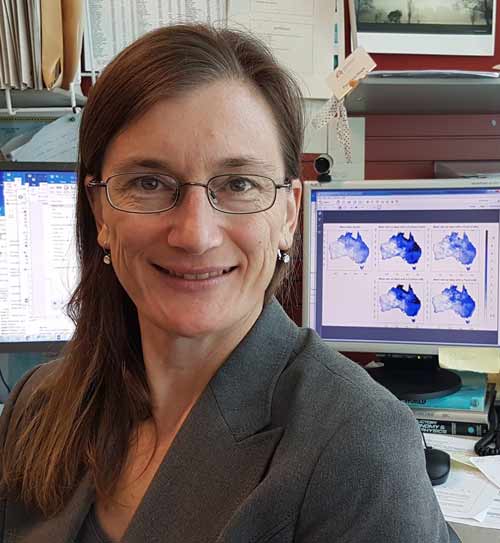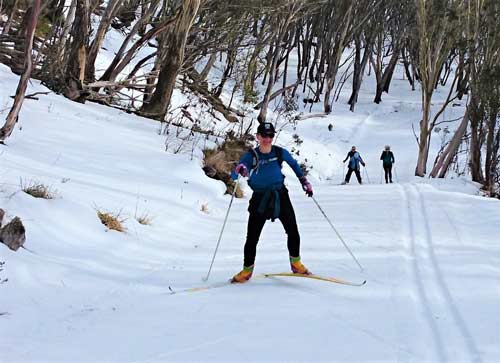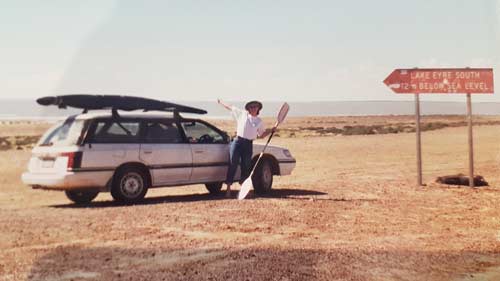Pandora Hope: From the snowfields to the IPCC
Science Alum, IPCC lead author and BOM research team leader Dr Pandora Hope shares how a love for cross-country skiing led to a career in climate research.
 A few years ago, climate researcher Pandora Hope (PhD Melb) was chosen as a lead author on the Intergovernmental Panel on Climate Change (IPCC), working on the framing and context chapter including leading a team of IPCC authors to summarise the critical science that puts the climate changes we've seen into historical context, and how confident we can be they are due to increased greenhouse gases.
A few years ago, climate researcher Pandora Hope (PhD Melb) was chosen as a lead author on the Intergovernmental Panel on Climate Change (IPCC), working on the framing and context chapter including leading a team of IPCC authors to summarise the critical science that puts the climate changes we've seen into historical context, and how confident we can be they are due to increased greenhouse gases.
“I love learning more about the world around me and how the global inter-connections work,” Pandora says of her work. “I also hope that our findings can help people to make well-informed planning decisions."
“Writing Chapter One means that we really need to be on top of all the main topics covered by the rest of the report. My role is to talk with other scientists and read and understand as much new climate literature as I can, synthesize it, and turn it into clear statements – including the confidence level - that can be understood by everyone outside of the climate science research community. It is a very different style to writing scientific papers.”
Skiing and weather charts
 Pandora’s interest in the dynamics of weather and climate systems began with a passion for cross-country skiing, which introduced her to the excitement of watching weather charts.
Pandora’s interest in the dynamics of weather and climate systems began with a passion for cross-country skiing, which introduced her to the excitement of watching weather charts.
“Seeing the ‘5400 m’ thickness line (an indicator of how much, or in this case how little, heat is in the atmosphere) shift up from the south and over Melbourne meant "SNOW!" on nearby hills, and time to wax the skis,” Pandora shares.
Having completed an undergraduate degree at Monash University with an interest in biological sciences and applied mathematics, Pandora began to focus on describing the year to year changes in the Southern Hemisphere winds in her honours year.
“(My supervisor) Professor David Karoly was keen for me to join his group and look at the major modes of climate variability over the Southern Hemisphere,” Pandora says. “It was fascinating trawling through the data archives from stations in Antarctica, the sub-Antarctic Islands as well as the tropics, and using statistics to see how variations across the Hemisphere are connected and why.”
All this groundwork prepared Pandora for her PhD and subsequent research career. “My honours year really set me up for my life-long professional passion - to really understand why the climate varies, and to understand how everything is inter-connected. Small changes in our climate can have huge impacts on people.”
Early career
Pandora started work at the University of Melbourne in 1994, as a research assistant for Professor Ian Simmonds on a project that sought to understand whether the wetness or dryness of Australia's soils and vegetation could act as a 'rainfall memory', and in turn influence the amount of rain in the months ahead.
It was during this time that Pandora first started ‘playing’ with global climate models and supercomputers.
“I'd get up at 2am to start new experiments so that the astrophysics and chemistry researchers wouldn't 'steal' my precious supercomputer nodes!” Pandora reveals.
It is amazing what you can do with these models of the globe's dynamical weather. I was putting virtual Glad Wrap on parts of the planet to block any evaporation from those surfaces to determine how much of Australia's rainfall was derived from evaporation from each region.
“Global Climate Models have been critical to my career, and it was great to have the chance to play with one back when the internet was only just beginning.”
Pandora carried this interest into her PhD at the University of Melbourne.
“I found myself doing research that had never been done before – using a physics-based Global Climate Model to look at the weather and climate of Australia at the Last Glacial Maximum, some 20,000 years ago when the globe was about 6°C cooler than it is now” Pandora recalls. “Studying Palaeoclimate is an excellent way to discover a great deal about how our planet works.”
“Using a Global Climate Model, I could ‘play God’, and cool the oceans, or alter the temperature gradient across the tropical Pacific and see what would happen, which was incredibly exciting,” she tells us. "It was like having another Earth that was all mine!"
It was at this time that Pandora met her now-husband.
“I met a lovely PhD student who (unofficially) had set up the University’s second web server, simply because he wanted an easy way to transfer the huge amounts of data that come out of a climate model,” Pandora smiles. “In those days, the usual way to transfer model data was on large tapes sent by post! I thought his idea was so excellent (among other things about him), that eight years later we married.”
Making a difference
 After her PhD Pandora joined the Bureau of Meteorology, where she had the opportunity to work on another modelling project - testing whether permanently flooding Lake Eyre would prevent drought in eastern Australia.
After her PhD Pandora joined the Bureau of Meteorology, where she had the opportunity to work on another modelling project - testing whether permanently flooding Lake Eyre would prevent drought in eastern Australia.
“Turns out the answer is 'no'. But if you flood all of South Australia you'll make a difference.” Pandora quips. “Although South Australians may not agree with doing that!”
A change in project leadership meant that Pandora adopted a senior position early on in her Bureau career.
“I was in the strange position of being quite junior, but also the only Bureau employee involved with a large research program funded by the West Australian government,” Pandora explains. “I had the opportunity to lead the Indian Ocean Climate Initiative (IOCI) to find out if changes in rainfall in W.A were a short-term variation or part of a longer-term shift. It was an intense but rewarding time, but ultimately it helped the WA government make some critical decisions. I knew my work was making a big difference to people.”
Since then, Pandora has been involved in numerous climate research projects, with a focus on understanding connections between weather systems, rain, temperature, the circulation of the atmosphere, and how rising greenhouse gases influence individual extreme events.
Pandora currently leads the Bureau of Meteorology's part of the Victorian Water and Climate Initiative.
“I'm now leading a large project with a great team of young climate scientists,” Pandora tells us. “We are intensely interested in the world around us, how it is changing, and how we can help future decisions about the world we find ourselves living in.”
Climate change misconceptions
“I believe in always questioning the science to better understand the world around us – that’s what a good scientist does. But there are some misconceptions about our changing climate,” Pandora says.
One misconception is that global warming means that the whole atmosphere will warm.
“Actually, there is structure to the change caused by increasing levels of atmospheric greenhouse gases. While the layer of the atmosphere where we live, the troposphere, is warming, the next layer up, the stratosphere, is actually cooling,” Pandora explains. “The pattern is termed a ‘fingerprint' of climate change – a pattern we expect due to increasing levels of greenhouse gases that can't really be caused by anything else. It is another line of reasoning that supports the hypothesis that climate change is caused by increasing levels of greenhouse gases in the atmosphere caused by burning the fossils of ancient forests.”
Another common misconception that Pandora hears is that climate change is caused by the ozone hole.
“It strikes me how well the ozone hole problem was communicated, along with the message about how we could avoid its continued destruction by avoiding certain chemicals in our aerosols and fridges,” Pandora says. “However, while CFCs are powerful greenhouse gases, and the upper level circulation over Antarctica is influenced by the 'signature' of climate change as well as ozone-destroying substances, the ozone hole is not a major cause of global climate change.”
Solving the problem
According to Pandora, her job is to do the science – to ensure policy and law makers have the best possible information on how the climate is changing and how it is likely to change in the future.
I try my best to make sure that everyone is as well-informed as they can be about how climate change is affecting us now and in the future.
While her work helps governments, Pandora also does what she can by helping out in her local community.
“I speak at my kid's primary school about the weather and climate,” Pandora says. “I’ve volunteered to speak at council sessions, and I say to people that there are many ways to make our future better - for instance watch the 2040 film, its uplifting!
“I’ve also put lots of solar panels on my roof, I eat less red meat than I used to, I try to ride my bike to work as often as I can instead of taking the car and train, I have my beloved worm farm and I even bought a white house which helps a tiny bit to keep the city cool.
My research is not just about hard numbers – it's about our future, and about making a difference.
You can connect with Pandora Hope on LinkedIn. While you're there, make sure to join the Science Alumni group to stay up to date on community news and events.